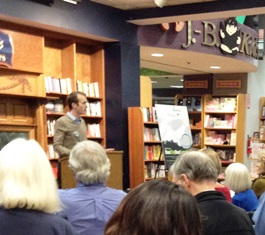
A CSO "Listening Party" is the Place to Be

Music brings people together. For the second year, the Cincinnati Symphony Orchestra has offered a series of eighteen listening parties held throughout Greater Cincinnati.
Designed to introduce the general public to Tchaikovsky’s Symphony No. 4 and Mozart’s Davide penitente, the parties feature such presenters as assistant conductor Will White, violinist Sylvia Samis and timpanist Patrick Schleker. "One City, One Symphony" is the name of the CSO program, which is offered at such places as Joseph-Beth Booksellers, College of Mt. St. Joseph, the Taft Museum and Hebrew Union College.
On October 29 at Joseph-Beth, Will White gave over 30 listeners an in-depth review of Tchaikovsky’s Symphony No. 4, explaining all four movements of the classic work. White also talked about Tchaikovsky’s personal life as it pertained to the masterpiece, which will be performed November 14 and 16 at Music Hall, along with Mozart’s Davide penitente, conducted by new music director Louis Langree.
From the perspective of a conductor and a composer, White depicted the pairing of Tchaikovsky's Symphony No. 4 and Mozart’s Davide penitente as appropriate, since Mozart was Tchaikovsky’s favorite composer. The Fourth Symphony is one of the most famous pieces by Tchaikovsky.
The symphony opens with 30 seconds of an intense motif representing inescapable fate. A student in Moscow in the 1860’s, Tchaikovsky began work on the symphony in 1876. Married to Antonina Miliukova for a short period of time, he expressed melancholy and depression, heard in the music with its emotional connection. A Russian waltz with three rhythmic layers is also heard in the score (first movement). From the Soviet Union, Tchaikovsky ended up in Italy. The sunniest part of the symphony reflects the three months he spent in Venice.
With four movements in the symphony, the first is the longest, with the main musical muscle. The fate theme ratchets up the tension to end the movement. While the first two movements are sad, the third and fourth are happier. Brass and timpani are used extensively. (There is an oboe solo in the second movement which every oboist practices.) The third movement expresses a happy mood with use of string pizzicato. The fourth movement starts with a bang, with cymbals crashing. The main melody, expressing a shift of mood, reflects a Russian folk song clothed in orchestral fabric. The theme builds, with the symphony ending happily.
The night I attended, there were a number of people in the crowd eager to learn more about Tchaikovsky’s Fourth. From the questions they asked, there was a lot of interest in both the composer and the piece.
To get an in-depth view of these concerts, consider attending a listening party. A complete list of parties, partners and WGUC broadcasts is available at www.cincinnatisymphony.org/onecity.